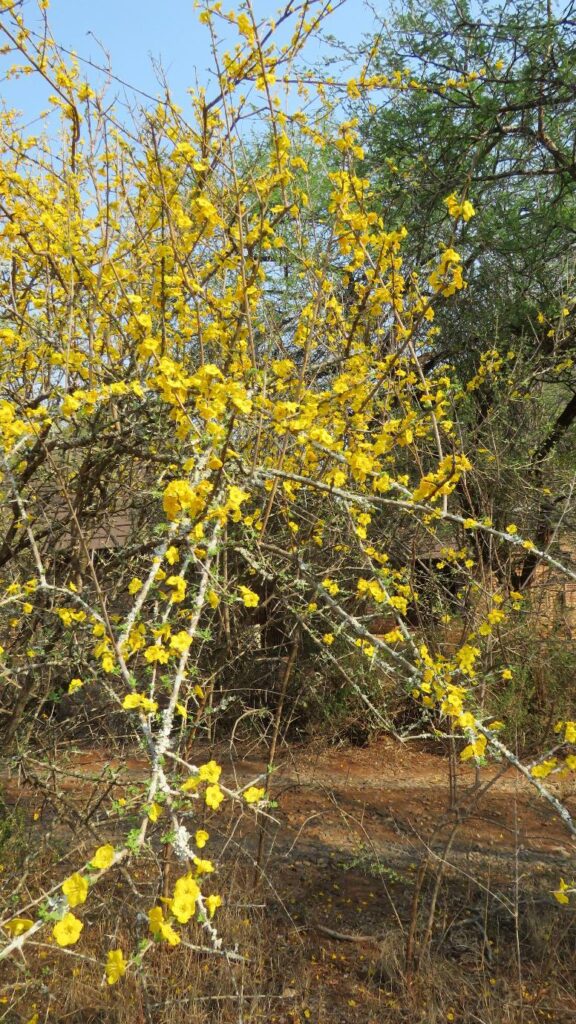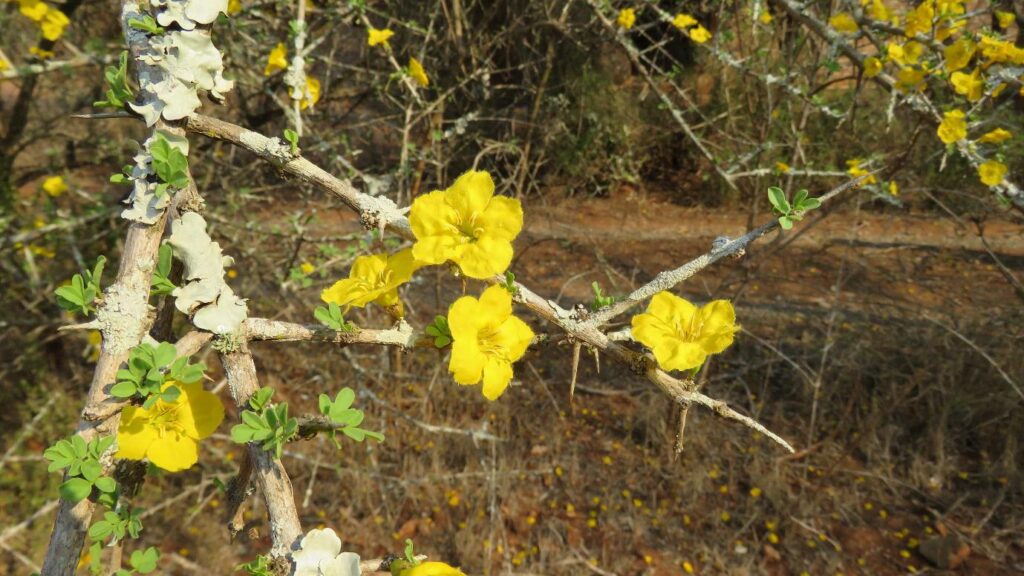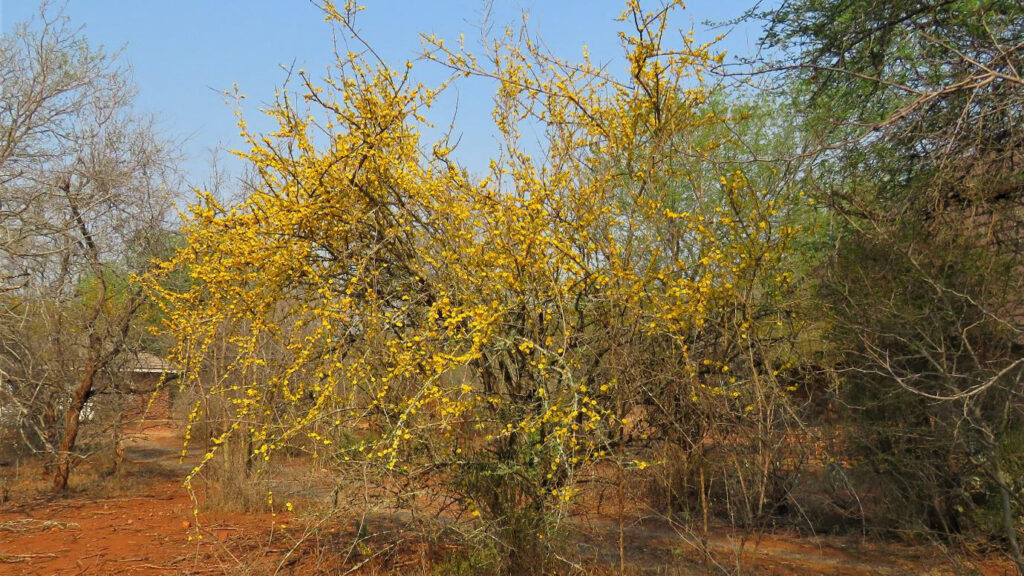What's Blooming In Marloth?
Throughout the year, we are blessed to have amazing indigenous plants that bloom in their own specific seasons. They can tell us things about the seasons, about the weather and sometimes, even the environment. So, join us as we see what’s blooming now and what we can learn…
Click here to see a list of locally indigenous flowers of Marloth Park.
1 June: Aloe Marlothii & Kalanchoe rotundifolia
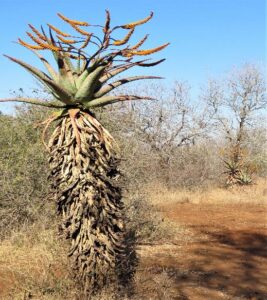
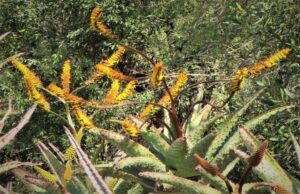
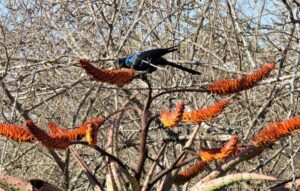
What better plant to introduce this new HR info series than our namesake, Aloe Marlothii? (E: Mountain Aloe; Z: uMhlaba; A: Bergaalwyn; S: Kgopha).
Set against our leafless, grey, winter trees, the fiery colours draw the eye. It is single stemmed, with heavily spined leaves and a magnificent, horizontally branched ‘candelabra’ or raceme. This carries the upward-facing, deep yellow, orange to red flowers. Marlothii occur only in the drier, rockier areas of north-eastern South Africa.
The scientific name honours H.W.R. Marloth (1855-1931). He was a chemist and botanist who made an enormous contribution to science in South Africa, Zimbabwe and Namibia.
But let’s not give all our attention to the big, showy flowers. In Marloth are a myriad small and dainty species to enjoy. Also blooming now is Kalanchoe rotundifolia. (E: Kalanchoe; A: plakkie; Z: umadinsane.)
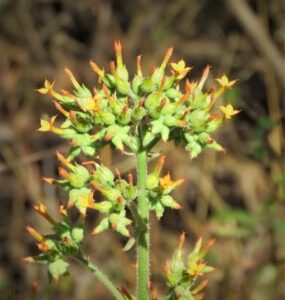
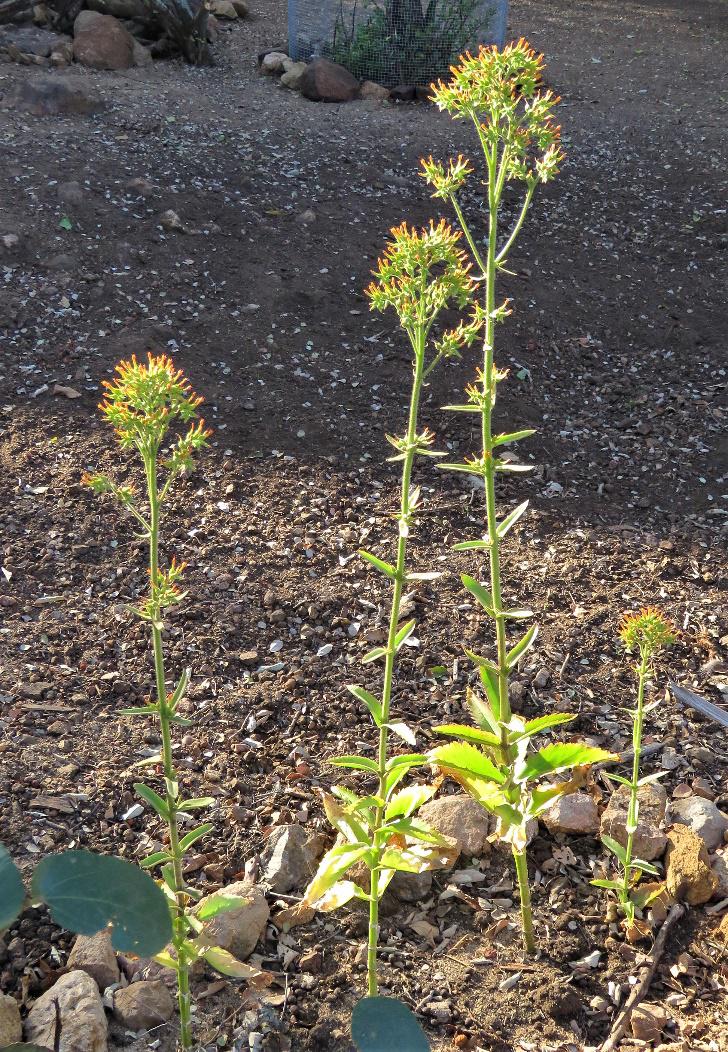
You’ll see these succulents in massed stands in dappled shade. The tiny tubular flowers are in clumps at the tip of a long, thin, furry stem that has sparse, fleshy leaves. The richer the soil, the taller (up to a metre) and more strongly coloured they are. Kalanchoe, like aloes, are easy to propagate from cuttings. (See PlantZAfrica (sanbi.org) for more.)
2 July: Mikania capensis & Justicia flava
This parched time of year makes our indigenous, lush green creeper, Mikania capensis, all the easier on the eye. It has attractive, downward pointing leaves and masses of delicate, white, feathery flowers. It likes a damp situation, so you will see it along the banks of watercourses now. Note that this creeper’s leaves and flowers look similar to the alien triffid, but you can see Mikania has typical winding creeper stems, unlike the stiff-stemmed triffid bush.
A lovely little forb (herbaceous plant) you want to encourage on your land is Justicia flava (E: Yellow justicia; A: Geelgarnaalbos; Z: Impela). They grow in most places, but where it is a little damp or shady you’ll still find these hardy little bushes flowering. Their leaves are also food for our grazers. They are common, so should appear if you don’t rake or sweep – you can see the example has grown out of nice thick leaf litter.
Note that Bush Nursery does have locally indigenous plants, or you can take a fun day trip to the big Skukuza nursery.
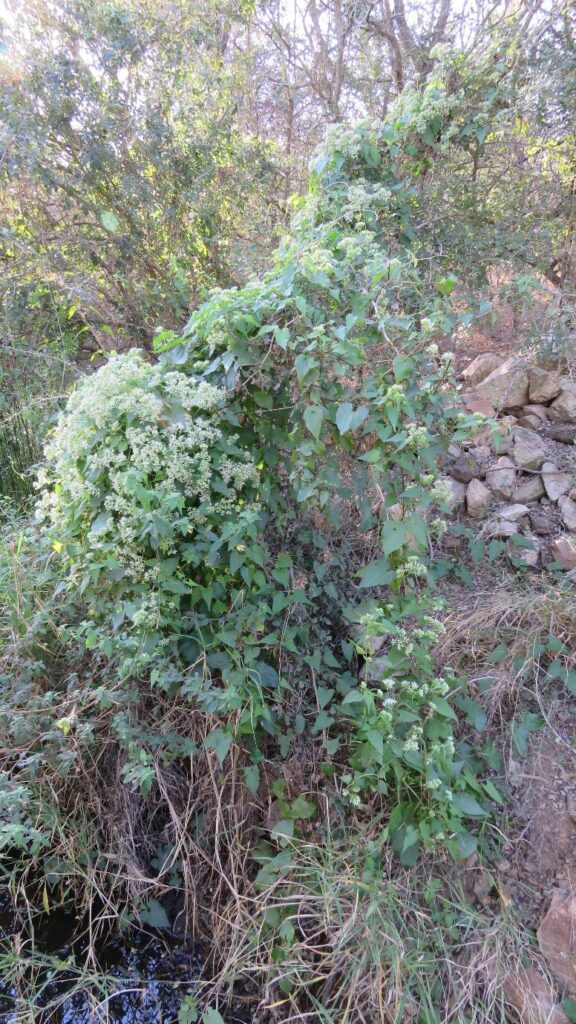
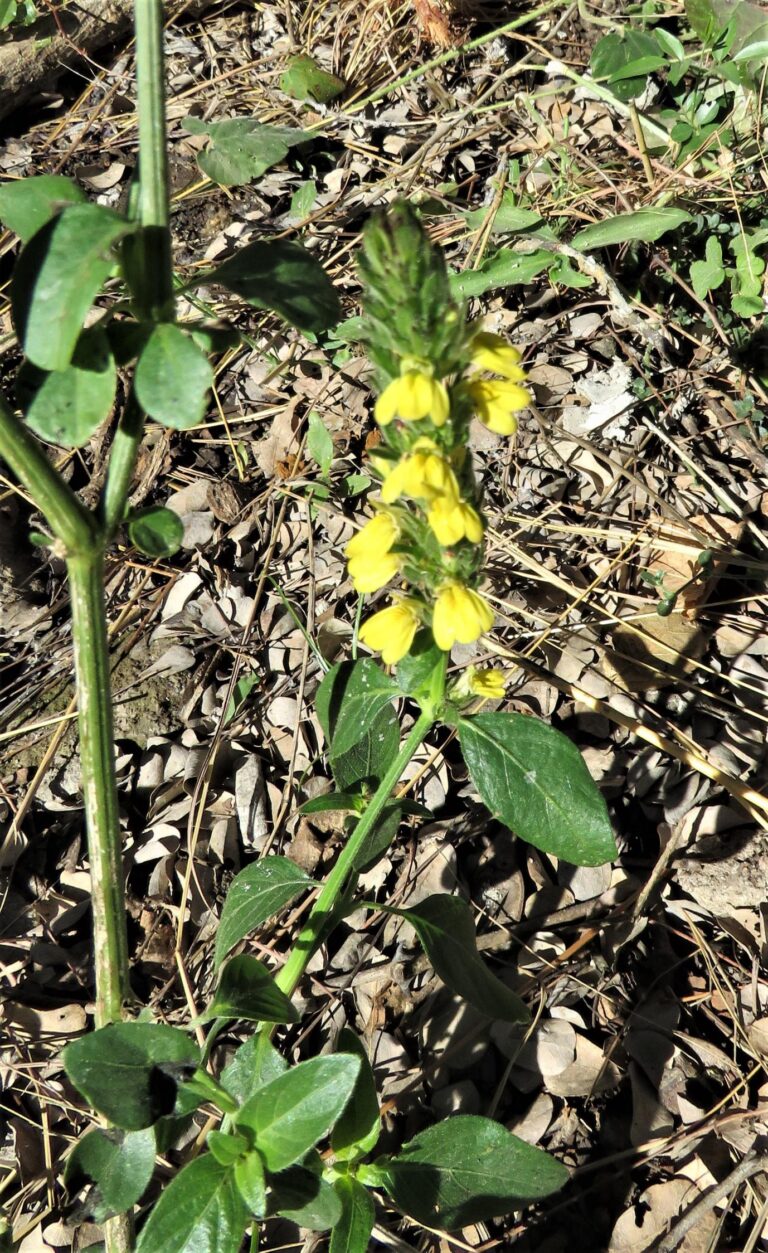
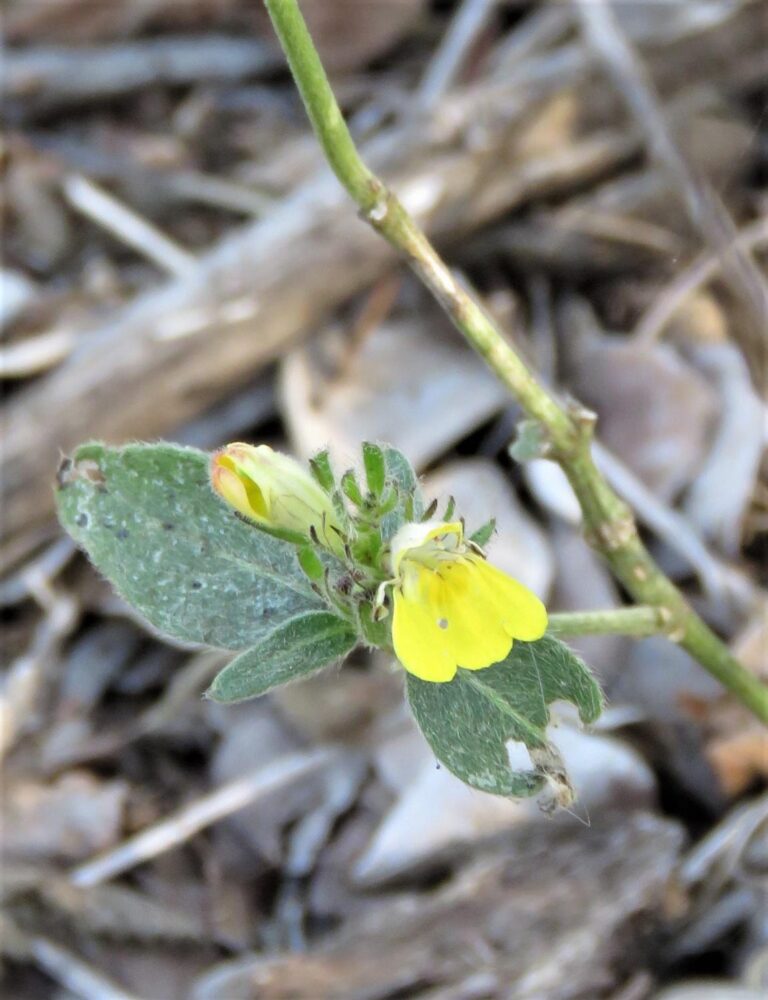
3 July: Aloe chaubaudii & Monechma divaricatum
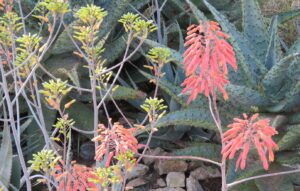
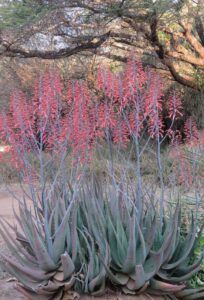
If you take a drive along Kudu Road down towards the river, and turn right into Mispel, you’ll find yourself in blooming aloe wonderland. All along the way home owners have cultivated massed stands of our local specialities: Aloe chabaudii * and Aloe marlothii. If you pause, you’ll see many sunbirds in particular, enjoying the bounty. Chabaudii are, however, plentiful all over Marloth.
This stemless aloe has smooth, greyish-green leaves and sends up a tall, much-branched inflorescence with pinkish-red rosettes. It’s a great garden plant as it sends out many suckers to create a dense mass of plants and blooms, and our antelope do not eat it. The species only occurs in the north east of the country.
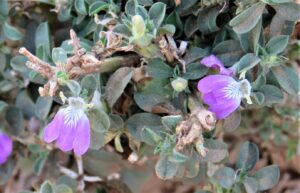
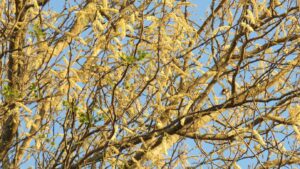
A reminder: our iconic Knob thorns are in flower. Look out for their masses of creamy-yellow sprays.
4 July: Impala Lily & Geigeria burkei
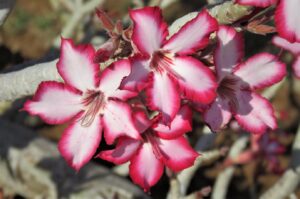
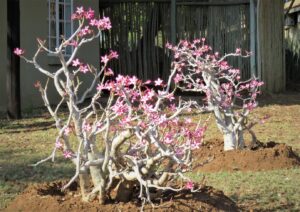
The winter beauty queen of the Lowveld is surely Adenium multiflorum, our succulent ‘impala lily’, uncommon in the wild. The intense colours of the starry flowers are showcased against their pale, smooth, leafless winter branches. One of its Afrikaans names, pylgif, reveals the dangerous side to this beauty: the sap is poisonous. They need sunny, well-drained conditions and although slow growing, are easy to cultivate from seed or cuttings.
In contrast, Geigeria burkei (A: Vermeerbos) is a hardy, abundant, quick-growing little perennial bush that blooms all year here. Even in dry July its cheerful, tiny yellow flowers can be seen nested in their evergreen circlets of long, slender leaves.
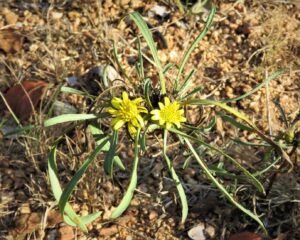
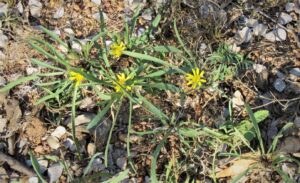
A bonus: none of our animals eat them. Perhaps they know something – iNaturalist says the common name is ‘button vomitdaisy’! Do any readers know this name for it? In parts of Marloth they grow even on the most inhospitable looking ground. If you do not rake or weed them out, they should easily establish themselves on your stand.
5 Aug: Flame Creeper Combretum microphylla
Very early spring’s the time to appreciate our reddish-crimson flame creeper, bright amongst the dried-off vegetation and leafless trees. Combretum microphyllum (A: vlamklimop; Sw: umHlalanyosi, ntsotsotso, mpfunta; Ts: ntsotsotso, mpfunta; V: mukopokopo; Z: iwapha) favours our hot, dry, low altitude conditions, doing well in bushveld and woodland. It is often found along river courses.
The prolific, upward-facing sprays of flowers have a wispy edged look, due to their long, fine stamens. Flame creeper has a fairly short blooming period – about 3 weeks in August/September – and then the small oval leaves appear. It is deciduous, and, like all Combretums, the pretty fruit are four-winged.
It attracts butterflies, and birds such as parrots and barbets, but sunbirds especially love it. Pollination is via butterflies and birds.
This wonderful addition to your stand is easy to grow from seed, and fairly fast growing. If you don’t plant it near a tree for support it will form a bush or small tree. It likes sandy soil and prefers full sun, or at least semi sun.
Note that Bush Nursery does have locally indigenous plants, or you can take a fun day trip to the big Skukuza nursery.
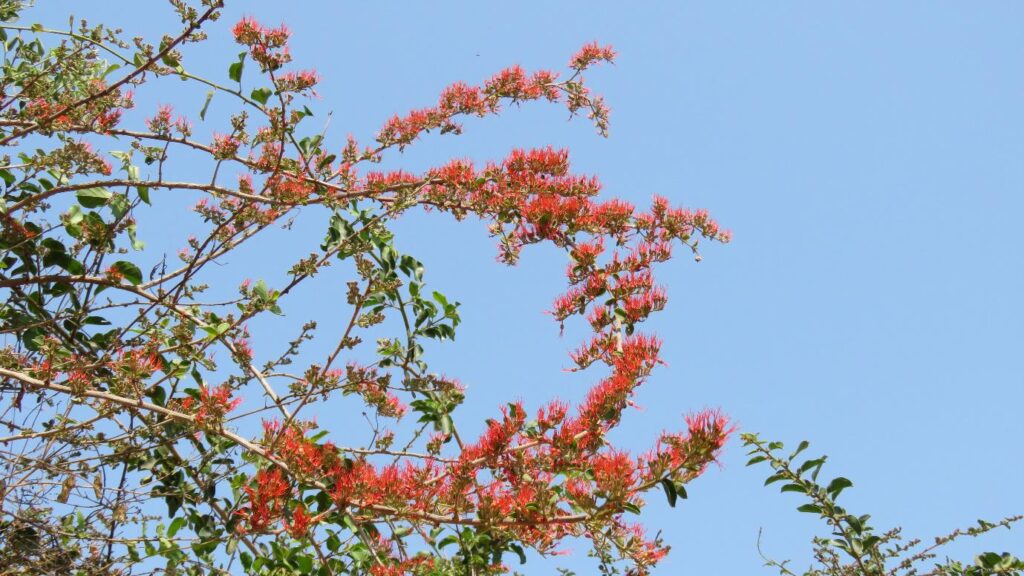
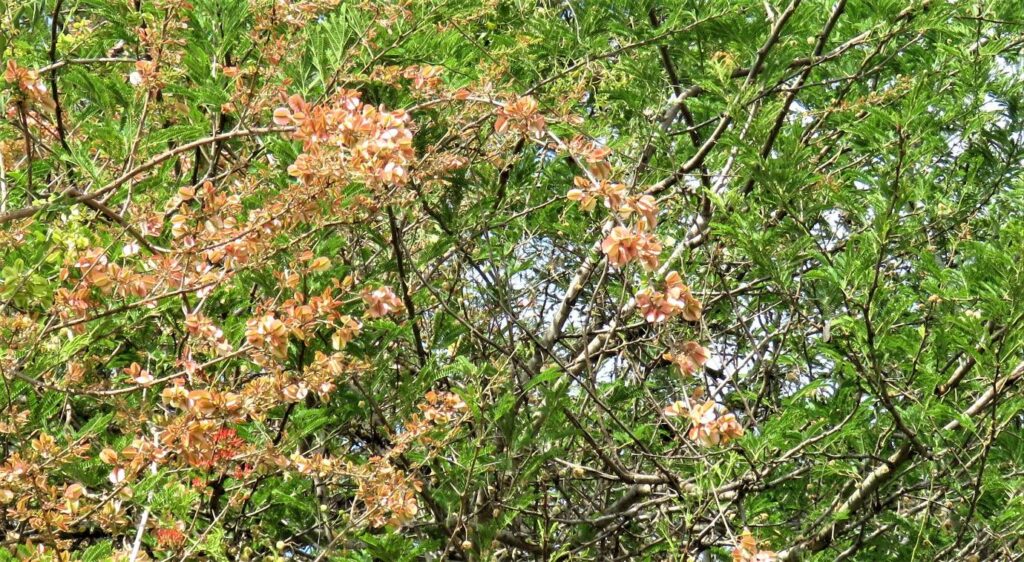
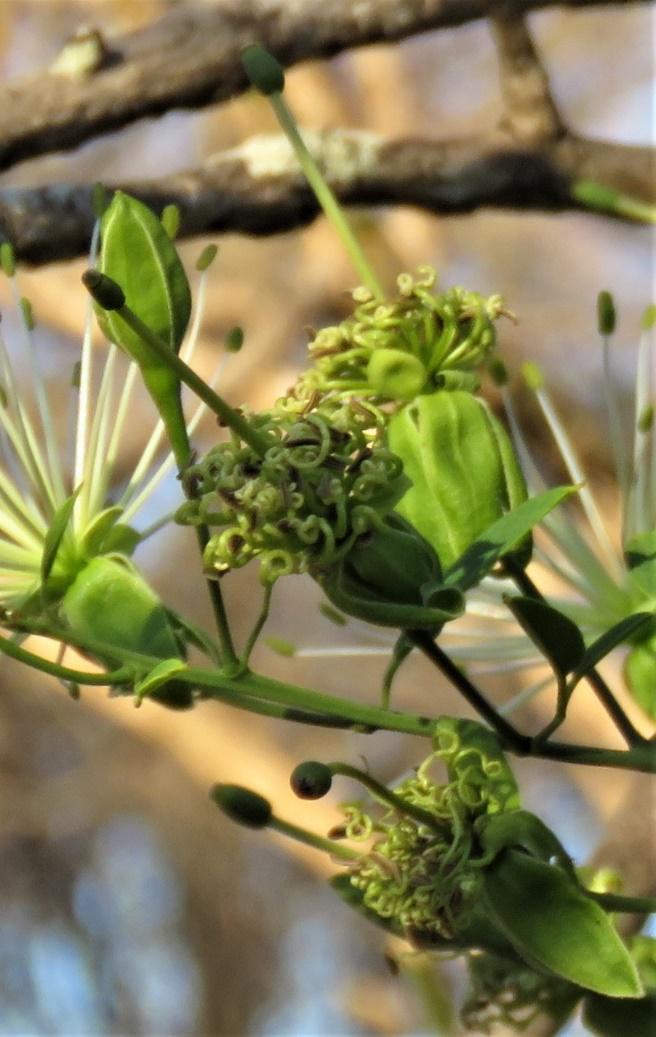
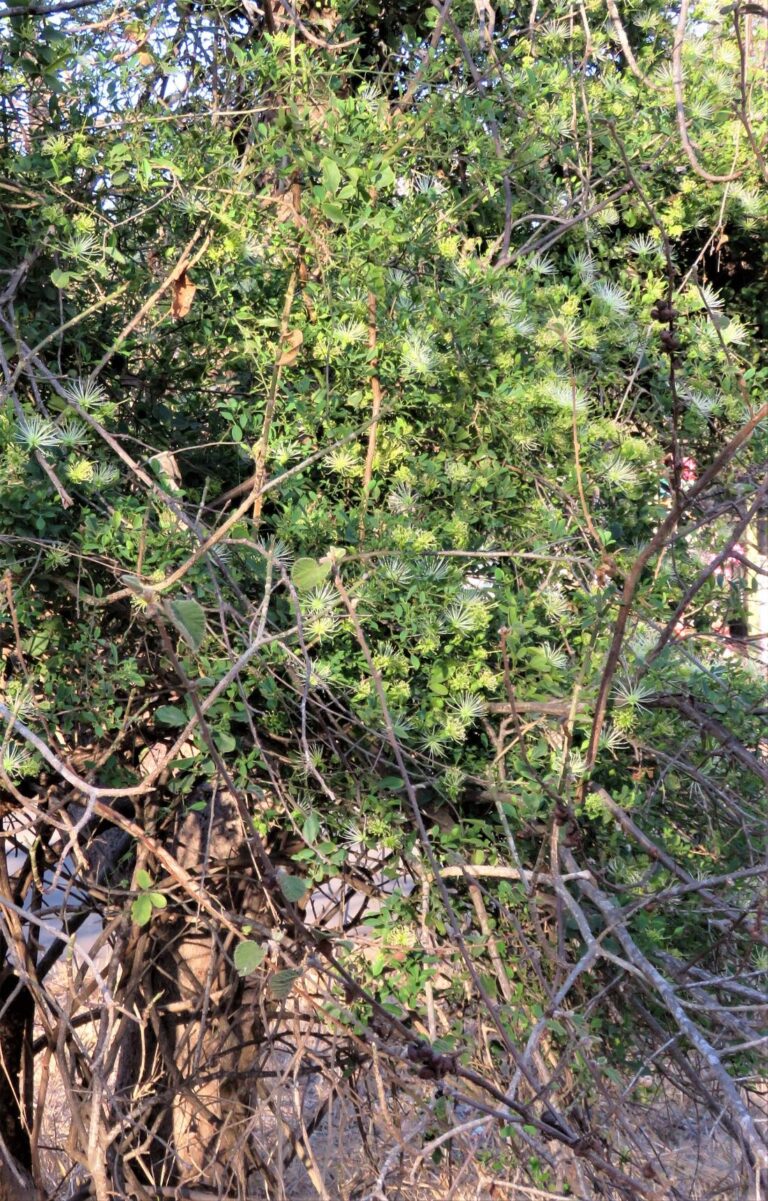
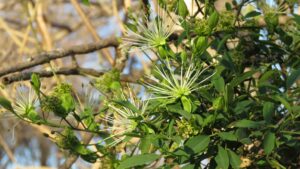
The sprinkling of rain we have had has revived some Geigerias, but otherwise flowers are scarce. However there are two delightful plants in full bloom: Dwarf bush cherry, a shrub, and Tree wisteria.
Dwarf Bush-cherry, Maerua parvifolia, (E: Small-leaved Spider Bush; A: Kleinblaar-witbos), is only found in the north east of South Africa. It is a woody shrub growing to about 2 metres and it likes hot, dry woodland, especially favouring termite mounds.
Its flowers have tiny petals but their spray of delicate, creamy white stamens, 1,5 cm long, make it very pretty. If you look closely you can see them bunched in a squiggly ball before they straighten out.
The tree wisteria, Bolusanthus speciosus, (A: Vanwykshout; NS: mogaba; Z: umHolo) remains a small tree under natural conditions in Marloth, but can grow fairly big. Its fragrant flowers are a rich lilac, appearing in beautiful pendant clusters. It is insect proof and grows fairly fast. Grey duiker and giraffe eat the leaves and pods.
SANBI says that, “The tree wisteria is certainly one of the most spectacular of our indigenous trees when in flower, mimicking the splendour of the jacaranda, which unfortunately is proving to be an invader species in parts of South Africa. Given time and effort this tree could replace the jacaranda trees from Argentina…”
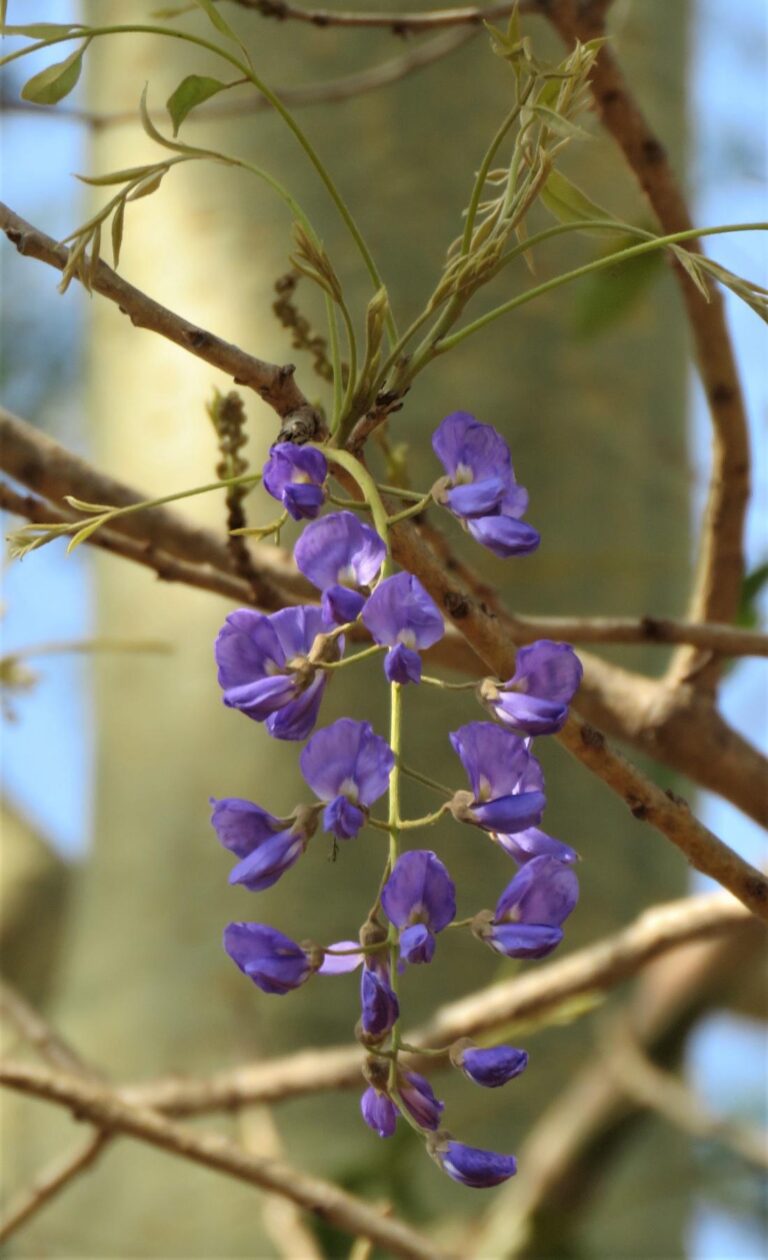
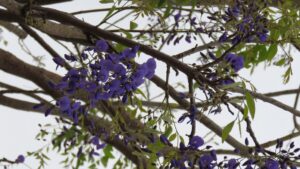
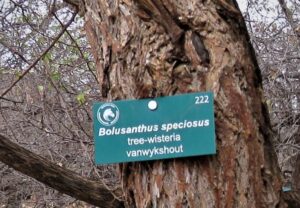
The photographed tree was tagged by Honorary Rangers. We offer this service for the price of the tags only.
7: Combretum mossambicense & Mopani Pomegranate
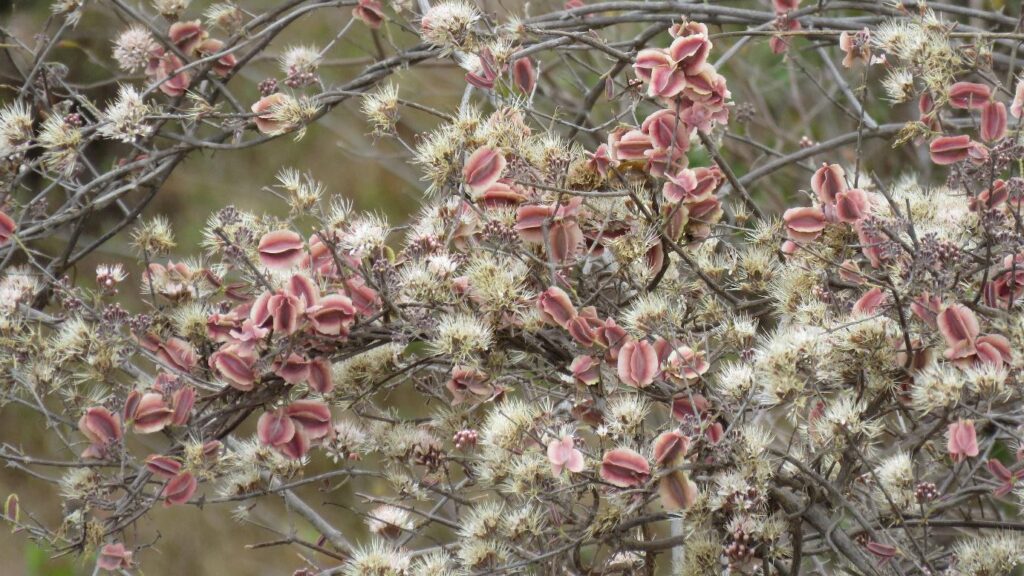
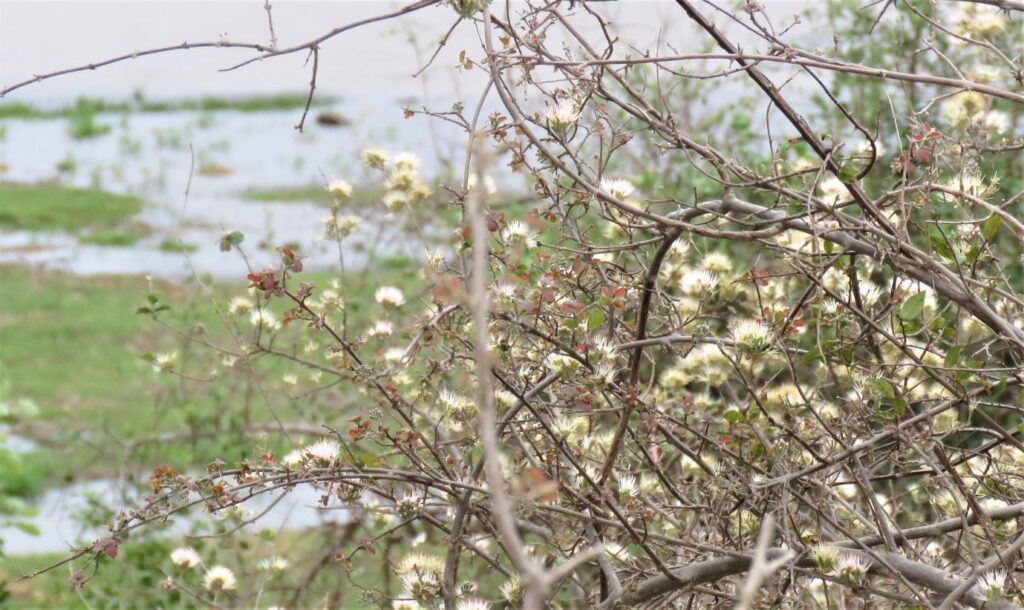
There are two lovely flowers to see right now, but sadly, the first is an indicator of how overgrazed we are. Along Figtree near Kudu, and along Crocodile Road, you will see bushes of it blooming abundantly just on the Kruger side of the fence. Our side … nothing! It probably suffers the same fate as so many of our flowering plants, browsed down to little nubs, just about staying alive. (More speed to our game management and veld restoration program!)
The knobbly climbing bushwillow, Combretum mossambicense, (A: knoppiesklimop) is a tough, deciduous scrambler with many trailing branches. In spring they are covered in a profusion of charming, fragrant, pinkish-white puffball flowers. As the flowers die the beautiful dusky pink, winged fruits appear, typical of Combretums. They dry off to brown in summer. It occurs only in the north east, loving our low-lying, hot, dry bushveld, and doesn’t mind poor soil. It favours riverine bush.
The second plant featured is not common here, and we had much debate about whether it occurs naturally, as it is not mentioned in many books. However, the experts have been consulted, say it is the only Rhigozum that does indeed grow here, and that we need posts to iNaturalist to get it more widely recorded. (Rhigozum obovatum (E: Karoo gold, yellow pomegranate; A: geelberggranaat) is a spiny, leggy bush, barely noticed when not in flower. It needs little water, and is hardy.
After the first rains, this Cinderella erupts into a showy ballgown of bright yellow blooms. They do not last long, but it may bloom again if the rains are intermittent. It does well when cultivated and this writer has found three healthy ‘wild’ shrubs in her neighbourhood. You can see specimens now on Bosbok, off Olifant near Kurper, off Soetdoring and on Kudu – but hurry!
